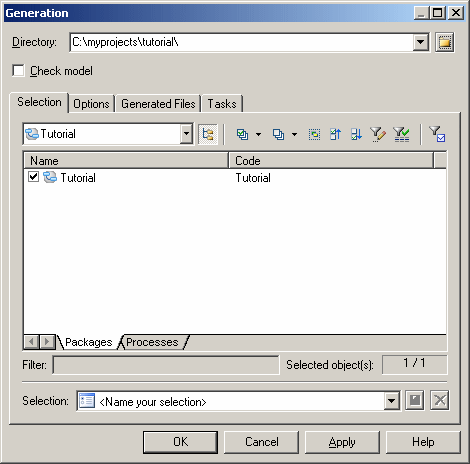

Chapter 8 Generating and Reverse Engineering Process Languages
Generating Process Language files from a BPM
By default, PowerDesigner supports the generation of the following types of files for the languages supported by the BPM:
| Process language
|
What is generated
|
|---|
| Analysis
|
No files generated as this language is used for modeling purposes only
|
| BPMN 1.0
|
No files generated as this language is used for modeling purposes only
|
ebXML BPSS v 1.01
ebXML BPSS v1.04
|
.XML files
|
BPEL4WS 1.1
WS-BPEL 2.0
|
.XML files
.WSDL files
|
| Sybase WorkSpace Business Process 2.x
|
.XML files
.XSD
svc_xyz (service files)
|
| Service Oriented Architecture
|
No files generated as this language is used to design the orchestration of processes without being linked to any particular platform or orchestration language
|
The PowerDesigner generation system is extremely customizable through the use of extended model definitions, profiles, and generation templates.
For detailed information about customizing the generation of your code, see Customizing and Extending PowerDesigner
.
 To generate process languages files:
To generate process languages files:
- Select Language → Generate language Code to open the Generation dialog box:

- Enter a directory in which to generate the files, and specify whether you want to perform a model check. For more information about checking your model, see "Checking a BPM" in the Working with BPMs chapter.
- [optional] Click the Selection tab and specify the objects that you want to generate from. By default, all objects are generated, and PowerDesigner remembers for any subsequent generation the changes you make.
- [optional] Click the Options tab and set any necessary generation options. For more information about these options, see the appropriate language chapter.
For information about editing the options that appear on this tab, see "Generation category" in the Resource Files and the Public Metamodel chapter of Customizing and Extending PowerDesigner
.
- [optional] Click the Generated Files tab and specify which files will be generated. By default, all files are generated, and PowerDesigner remembers for any subsequent generation the changes you make.
For information about customizing the files that will be generated, see "Templates and Generated Files" in the Extending Your Models with Profiles chapter of Customizing and Extending PowerDesigner
.
- [optional] Click the Tasks tab and specify any additional generation tasks to perform. For more information about these tasks, see the appropriate language chapter.
For information about adding your own generation tasks, see "Generation category" in the Resource Files and the Public Metamodel chapter of Customizing and Extending PowerDesigner
.
- Click OK to begin generation.
A Progress box is displayed. The Result list displays the files that you can edit. The result is also displayed in the Generation tab of the Output window, located in the bottom part of the main window.
All files are generated in the destination directory.
 Extending generation with XEMs
Extending generation with XEMs
You can attach an extended model definition (.XEM) to your model to extend the generation process. For more information, see "Extended Model Definitions" in the Resources Files and the Public Metamodel chapter of
Customizing and Extending PowerDesigner
.
|
Copyright (C) 2008. Sybase Inc. All rights reserved.
|

|


![]() To generate process languages files:
To generate process languages files:
